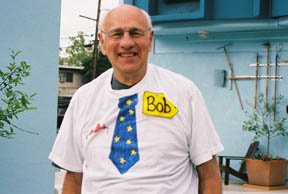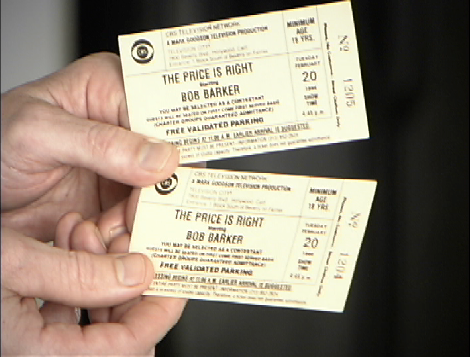"Hoping to 'Come on Down' to 'The Price Is Right'"
By JENNIFER STEINHAUER
Published: June 13, 2006
By JENNIFER STEINHAUER
Published: June 13, 2006

Ted Ott (pointing) leads a workshop at the Farmer's Daughter hotel for "The Price Is Right" hopefuls; some line up, beginning at midnight (middle), and are later issued a number (right).
LOS ANGELES — The daytime television schedule may be littered with gabby talk shows, sunny news programs and adjudications of who, precisely, put his foot through the window of the neighbor's El Camino.
But nearly 35 years since Bob Barker first beckoned Americans to come on down, his game show, "The Price Is Right," continues to corner a certain market.
Thousands of fans — from 19-year-old Midwestern college students to octogenarians who have had crushes on Mr. Barker since he and they were middle-aged — continue to line up along Fairfax Avenue here at 3 a.m., four days a week, most of the year, hoping for one of the 325 spots in the studio audience.
They come in intergenerational groups or solo. They schedule vacations around tapings of the show, and spend months organizing friends and family members to meet them here, wearing T-shirts that identify them by their town or family name. (One man was recently spotted refusing to don his group's shirt at breakfast. Things did not go well for him.)
They stay by the dozens at the Farmer's Daughter hotel across the street from the CBS studio where "The Price Is Right" is taped, and get a nightly tutorial from a desk clerk on how to become members of the studio audience.
For every American who dreams that a singing voice, dance skills or back-stabbing boardroom tactics will earn him a piece of prime-time fame, thousands more have dreamed smaller, longing only to guess the price of a sectional couch or a pint of heavy cream. They don't want a record contract; they want an all-expenses-paid trip to Asia, or maybe a banjo.
"I have been watching this show all my life," said Gregory Bourgard, 26, who comes several times a year from Odenton, Md., to line up for a spot in the audience, even though he can never be a contestant again because he was once a showcase winner.
"I'm not trying to relive the moment," he said on a recent Sunday night at the Farmer's Daughter, where he was gearing up for visit No. 30. "I just want to be in the audience again."
Game shows may come and go, but "The Price Is Right" is a cultural touchstone for generations of Americans.
Who under 50 — except for those raised by parents who banned television and put rice cakes rather than Ring Dings in their lunchboxes — did not spend dozens of childhood mornings zoned out on the couch, playing along with the Dice Game or screaming at the fool from San Diego about to overbid on a bag of corn chips?
"We're here for our parents, our grandparents and people in our lives who have since passed on who watched the show," said Cindy Kilkenny, 57.
It is the democracy of the audience, and the show's theme — how to gauge inflation, essentially — that has sustained its appeal, said Mr. Barker, the show's 82-year-old host (and its executive producer).
"Everyone in the United States can identify with our show," he said. "On most game shows today you will see contestants between 20 and 45 who are physically attractive. We have people on 'The Price Is Right' who are between 20 and 45 who are physically attractive too."
"But we have people who, when they became 18, the first thing they did was come to 'The Price Is Right,' " he continued, "and I had a big winner on a recent show who was 95. We deliberately select contestants that are black, white and brown. We deliberately pick contestants from all over the United States. We have fat people, thin, short, tall, you name it."
How much stuff costs, he added, is what people think about every day, anyway. "The premise is so overpowering," he said. "Everyone identifies with prices. Whether you're a television executive or a newspaper reporter or a policeman or unemployed."
And while television may worship 22-year-olds and body parts created in the operating theater, Mr. Barker is also part of the show's grand appeal, and he has the X-rays to prove it. One overzealous fan bear-hugged Mr. Barker and broke a rib; several have crushed his toes; and one raced onto the stage and head-butted him in the solar plexus.
"It is a dangerous job," said Mr. Barker, who holds special affection for a fan who raced to her contestant's seat with such enthusiasm that her tube top fell down. She failed to adjust it for several live minutes.
The audience is largely filled by groups on buses who are guaranteed seats. The rest are fans who line up, often beginning at midnight, for the extra spots, which are doled out on a first-come-first-served basis. Some days there are two, others 200.
For these fans Ted Ott, a clerk at the Farmer's Daughter, gives free workshops each night before tapings (two on Mondays and one Tuesday through Thursday).
Mr. Ott, who lines up on his day off, uses a broken section of a backgammon board to represent the "Price Is Right" studio, and lectures for roughly 40 minutes, in between checking in guests.
He gives the following advice: Do not wear costumes. ("The show's producers have a horror of waking up and finding out they are on 'Let's Make a Deal,' " he said.) Show up on time to get your four-digit line-spot number, and guard it with your life.
If you get a spot in the audience — and are thus granted a 20-second interview with the producer to see if you might be called down — be clever. Don't go to the restroom when people are being called down. If you are thinking of bringing in a cheat sheet on prices, think again, because that is a felony.
But to that quintessential American question: is it worth it? For Sean Steiner, 22, who came from Akron, Ohio, to be the first in line for the show, it was the fulfillment of a childhood dream. "It was a once-in-a-lifetime experience," he said. "I was feet from Bob. He was cracking jokes, telling stories about the ducks who live in his swimming pool during the commercial break. The best part was, I got to come home and watch myself on TV."



No comments:
Post a Comment